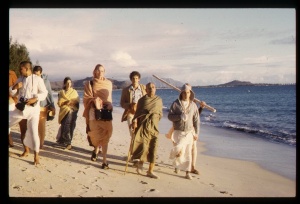CC Adi 11.39 (1975): Difference between revisions
(Vanibot #0027: CCMirror - Mirror CC's 1996 edition to form a basis for 1975) |
(Vanibot #0020: VersionCompareLinker - added a link to the Version Compare feature) |
||
| Line 2: | Line 2: | ||
<div style="float:left">'''[[Sri Caitanya-caritamrta (1975)|Śrī Caitanya-caritāmṛta (1975)]] - [[CC Adi (1975)|Ādi-līlā]] - [[CC Adi 11 (1975)|Chapter 11: The Expansions of Lord Nityānanda]]'''</div> | <div style="float:left">'''[[Sri Caitanya-caritamrta (1975)|Śrī Caitanya-caritāmṛta (1975)]] - [[CC Adi (1975)|Ādi-līlā]] - [[CC Adi 11 (1975)|Chapter 11: The Expansions of Lord Nityānanda]]'''</div> | ||
<div style="float:right">[[File:Go-previous.png|link=CC Adi 11.38 (1975)|Ādi-līlā 11.38]] '''[[CC Adi 11.38 (1975)|Ādi-līlā 11.38]] - [[CC Adi 11.40 (1975)|Ādi-līlā 11.40]]''' [[File:Go-next.png|link=CC Adi 11.40 (1975)|Ādi-līlā 11.40]]</div> | <div style="float:right">[[File:Go-previous.png|link=CC Adi 11.38 (1975)|Ādi-līlā 11.38]] '''[[CC Adi 11.38 (1975)|Ādi-līlā 11.38]] - [[CC Adi 11.40 (1975)|Ādi-līlā 11.40]]''' [[File:Go-next.png|link=CC Adi 11.40 (1975)|Ādi-līlā 11.40]]</div> | ||
{{CompareVersions|CC|Adi 11.39|CC 1975|CC 1996}} | |||
{{RandomImage}} | {{RandomImage}} | ||
==== TEXT 39 ==== | ==== TEXT 39 ==== | ||
| Line 32: | Line 31: | ||
<div class="purport"> | <div class="purport"> | ||
Sadāśiva Kavirāja and Nāgara Puruṣottama, who were father and son, are described in the Caitanya-bhāgavata as mahā-bhāgyavān, greatly fortunate. They belonged to the vaidya caste of physicians. The Gaura-gaṇoddeśa-dīpikā, verse 156, says that Candrāvalī, a most beloved gopī of Kṛṣṇa's, later took birth as Sadāśiva Kavirāja. In verses 194 and 200 it is said that Kaṁsāri Sena, the father of Sadāśiva Kavirāja, was formerly the gopī named Ratnāvalī in Kṛṣṇa's pastimes. All the family members of Sadāśiva Kavirāja were great devotees of Lord Caitanya Mahāprabhu. Puruṣottama dāsa Ṭhākura sometimes lived at Sukhasāgara, near the Cākadaha and Śimurāli railway stations. All the Deities installed by Puruṣottama Ṭhākura were formerly situated in Beleḍāṅgā-grāma, but when the temple was destroyed the Deities were brought to Sukhasāgara. When that temple merged into the bed of the Ganges, the Deities were brought with Jāhnavā-mātā's Deity to Sāhebaḍāṅgā Beḍigrāma. Since that place also has been destroyed, all the Deities are now situated in the village named Cānduḍe-grāma, which is situated one mile up from Pālapāḍā, as referred to above. | |||
</div> | </div> | ||
Latest revision as of 14:33, 26 January 2020

A.C. Bhaktivedanta Swami Prabhupada
TEXT 39
- ājanma nimagna nityānandera caraṇe
- nirantara bālya-līlā kare kṛṣṇa-sane
SYNONYMS
ājanma—from birth; nimagna—merged; nityānandera—of Lord Nityānanda Prabhu; caraṇe—in the lotus feet; nirantara—always; bālya-līlā—childish play; kare—does; kṛṣṇa-sane—with Kṛṣṇa.
TRANSLATION
From birth, Puruṣottama dāsa was merged in the service of the lotus feet of Lord Nityānanda Prabhu, and he always engaged in childish play with Lord Kṛṣṇa.
PURPORT
Sadāśiva Kavirāja and Nāgara Puruṣottama, who were father and son, are described in the Caitanya-bhāgavata as mahā-bhāgyavān, greatly fortunate. They belonged to the vaidya caste of physicians. The Gaura-gaṇoddeśa-dīpikā, verse 156, says that Candrāvalī, a most beloved gopī of Kṛṣṇa's, later took birth as Sadāśiva Kavirāja. In verses 194 and 200 it is said that Kaṁsāri Sena, the father of Sadāśiva Kavirāja, was formerly the gopī named Ratnāvalī in Kṛṣṇa's pastimes. All the family members of Sadāśiva Kavirāja were great devotees of Lord Caitanya Mahāprabhu. Puruṣottama dāsa Ṭhākura sometimes lived at Sukhasāgara, near the Cākadaha and Śimurāli railway stations. All the Deities installed by Puruṣottama Ṭhākura were formerly situated in Beleḍāṅgā-grāma, but when the temple was destroyed the Deities were brought to Sukhasāgara. When that temple merged into the bed of the Ganges, the Deities were brought with Jāhnavā-mātā's Deity to Sāhebaḍāṅgā Beḍigrāma. Since that place also has been destroyed, all the Deities are now situated in the village named Cānduḍe-grāma, which is situated one mile up from Pālapāḍā, as referred to above.